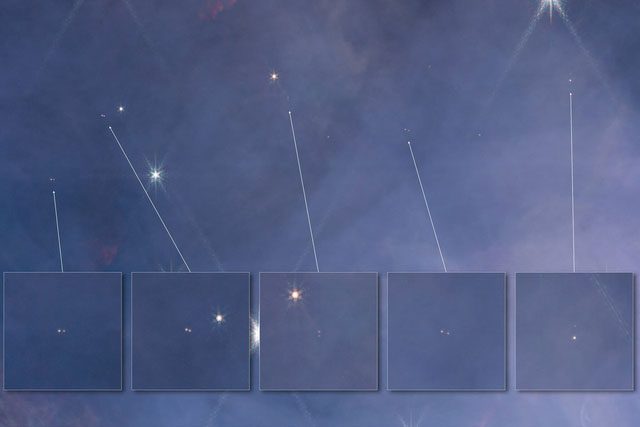The professor leading the new project has handed over the task of identifying these “planets” to theorists.
Using the James Webb Space Telescope, scientists have discovered “planets” adrift in space that do not belong to any star system. Indicators suggest that two strange celestial bodies are moving in pairs, leaving astronomers astonished and unable to provide an explanation.
The pair of celestial bodies has been nicknamed Jupiter Mass Binary Objects (abbreviated as JuMBO, meaning “Jupiter Mass Binary Objects”). It is theorized that these celestial bodies formed in a region of space where the density of matter is insufficient to constitute a complete star.
Some researchers believe that these could be planets that have been ejected from their star systems due to physical interactions. According to Professor Mark McCaughrean, senior scientific advisor at the European Space Agency (ESA), the hypothesis of planets being ejected from their star systems is gaining broad acceptance.
“The physical interaction of gases suggests that objects with mass equivalent to Jupiter cannot form on their own, and we already know how a single planet can be ejected from such a star system. But how can you eject a pair of stars? Currently, we have no answer. This is a field for theorists,” noted McCaughrean.

The JuMBO celestial pair.
Professor McCaughrean is leading efforts to survey the Orion Nebula, a bright emission nebula located in the Orion constellation and the largest star-forming region known closest to Earth. In addition to the cluster of four central stars known as the Trapezium, the Orion Nebula – designated M42 – can be seen with the naked eye, despite being about 1,400 light-years away from Earth.
Using advanced infrared sensors, astronomers continuously observed M42 for over a week, capturing 700 images. These images were combined to create a scene of a vast area, so large that a spacecraft traveling at the speed of light would take over four years to traverse the described region.
This area contains thousands of young stars of varying sizes, from stars 40 times heavier than the Sun to celestial bodies only 0.1 times the mass of our star.
Among them, many stars are obscured by massive accretion disks of gas and dust. Some of these stars are in the process of forming, while others are being torn apart by ultraviolet radiation and galactic winds emitted from nearby stars, especially from those in the Trapezium cluster.

The Orion Nebula captured at short (left) and long (right) wavelengths.
The image above shows the same nebula displayed at two different wavelengths of light. The differences in color indicate various features of the Orion Nebula.

Material ejected from the Luhua 1 Molecular Cloud.
In the long-wavelength version, we see clusters of green gas, indicating that this area is rich in polycyclic aromatic hydrocarbons (PAH), compounds commonly found in space and produced by stars.
Additionally, red beams emanating in one direction represent a flow of material ejected from the Luhua 1 Molecular Cloud, indicating a massive amount of hydrogen being expelled due to the energy generated from the collision of two stars. The flow rate of material reaches up to 100 km/s, suggesting that the collision event occurred only a few hundred years ago (in local time). The peak of the material flow is tinted with green, indicating a location rich in gaseous iron.
In a massive image of 21,000 × 14,500 pixels rich in detail, the JuMBO celestial pair is particularly noteworthy. According to Professor Heidi Hammel, who works on the Webb telescope project but is not involved in the new research, this event is unprecedented. Simulation models have never shown the possibility of a pair of planets being ejected from a star system.
As Professor Mark McCaughrean noted earlier, with no explanation for this strange phenomenon yet, the task will have to be handed over to the imagination of theorists. This celestial pair could represent a duo of planets operating contrary to the laws of physics, or they might become unidentified flying objects in Earth’s sky in the future.





















































